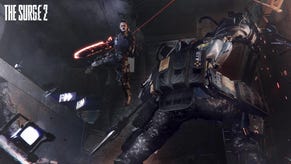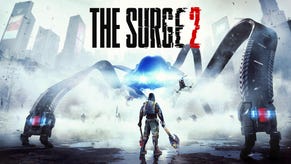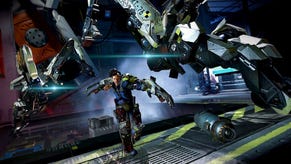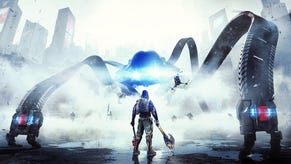The Surge 2 Review: Deck 13 Takes a Proper Step Out of From Software's Shadow
Deck 13 continues to march forward in the increasingly-crowded Soulslike genre.
This article first appeared on USgamer, a partner publication of VG247. Some content, such as this article, has been migrated to VG247 for posterity after USgamer's closure - but it has not been edited or further vetted by the VG247 team.
Like every beloved genre, there are the standard-bearers, and then there is the glut. Nobody understands this better than Deck 13, the Frankfurt-based studio that was one of the first to imitate FromSoftware with the earnest, but flawed Lords of the Fallen. That game wore its heart on its sleeve to a fault, making the studio's follow-up, 2017’s The Surge, a breath of fresh air. While The Surge was a good step, it is not a great game. What it represents, though, is a fascinating look at a dev in evolution—working hard to make creative choices and fix past mistakes to become a heavyweight in a specific genre. It has found its niche, and is sticking to it. You have to respect that.
So, it is with pleasure that I tell you that The Surge 2 is a fundamentally better game than its predecessor. This is a developer leaning into what it was best at while addressing major flaws from its past work. It is what every good sequel should be.
In broad strokes, The Surge 2 is a brisk, densely packed metroidvania. The story picks up immediately after the ending of the first game and shifts the location from an overrun factory to a downtown cityscape. Instead of taking the role of the first game’s anemic hero Warren, players can create their own silent protagonist from the character generator, which is a nice cosmetic addition to the game.
More on the practical side are the improvements to the crafting system, which is far less vague than the first game. As with the first Surge, the defining trait of The Surge 2 is obtaining armor schematics and materials to craft from enemies. In fact, after the brief tutorial level, you’re basically hit over the head repeatedly to upgrade your gear, and the methods for doing so. If you somehow forget what you need to do or accidentally skip past the help text, the tooltips that walk you through obtaining the necessary items are plastered on the walls of the starting areas for the entirety of the game.
It also helps that it’s a good system, if a little grind-heavy. Enemies in the game wear various pieces of armor sets that can be broken off by targeting specific limbs in combat. Break off, say, an arm for the first time and you obtain the schematic for that armor. Break the arm again and you’ll receive the forging material for it. Deck 13 took an “if it ain’t broke” approach to this since it’s exactly the same as the original game, and finding new enemies in each location made me salivate over what kind of armor set bonuses I could score off of them. It appeases both the practical player that only wants more statiscal muscle and the obsessive collector that wants to see and own everything.

Implants that augment abilities and add consumables health refills are now tied to the first major adjustment to the combat, a sort of battery-based energy system. Like the first game, your character has weighty movement in melee, even with the faster weapons like claws. By landing hits, they charge a blue meter with benefits tied to implants. Standard healing, for instance, uses one battery, which must be charged in battle, though batteries can be pre-charged if there’s leftover power. As batteries slowly drain outside of combat, players need to be efficient in their use, both in the heat of the moment and planning for future encounters. It’s a smart shift away from a similar meter in the first game that controlled a drone for ranged combat, which is untethered now in favor of a more useful ammo system.
In conjunction, both the mountain of available armor set bonus and the implants connected to the battery system makes for loadout combinations that practically beg the player to break the game, which is awesome. Certainly, most players will be happy to find a suit that either looks fashionable or offers the most attractive bonuses. But there is enough stuff to collect and fiddle with that the obsessive tinker will likely destroy this game. If you are this person, The Surge 2 will obliterate whole weekends.
Another evolution of the combat is a new parry system for deflecting attacks. More than simply holding the blocking button at the right moment, it’s now direction-based working off the right analog stick; a handy arrow appears on the screen indicating the side the hit is coming from, giving the player a bit of time for a more active defense. This is a system that Deck 13 wants you intimately familiar with by the end of the first hour—you can’t even dodge out of the way of incoming hurt until you make it to the end of the tutorial, only block and parry attacks. If playing the game nimbly is your preferred style, then, this will frustrate you in the long haul. Certain enemies can only be beaten by employing the parry system by the end of the game, making for something of a skill threshold that will assuredly make some people bounce off of this. While certain implants can help with parry timing, and the vast majority of foes can be beaten by just bobbing and weaving, it never felt egregious, but you’ll be forced at points to use this system whether you like it or not, and is a detriment over all.

The real draw is downtown Jericho City itself. After the brief tutorial prison level, The Surge 2 is set in a town run down by plague and catastrophe. It feels open and freeing, even if it isn’t an open-world game per say. There are plenty of paths to take to scavenge for new gear, and with the occasional higher level enemies roaming around, ambitious and gutsy players are given the opportunity to score nice upgrades early if they want to test themselves. The first game gated off enough that you always felt just tall enough to ride the ride. Here, you’re given the opportunity to get far enough ahead that you’re at a real advantage if you’d like to place yourself in harm’s way. It’s a good enough trade off that never feels like you’re gaming the system.
The downtown area is less a block of Swiss cheese and more a conspiracy theorists’ yarn-strewn cork board; paths weave back to previous locations in surprising (and surprisingly vertical) ways. While the actual size of the levels—all discrete with a few non-combat zones in between—are relatively small when judging overall real estate size, fully wrapping your head around where you are and what the next destination is can get a little challenging. It leads to plenty of "A-hah!" moments, though, when you realize just how far you’ve come and how easily you can get back to where you were.
It can go a bit overboard, though. Pathfinding was perhaps the first Surge's major flaw. It was very easy to lose track of what the next objective was and how to go about getting to it. The sequel is better in this regard. Quests and side missions are neatly listed in the pause menu, but after The Surge 2 takes its midgame twist, directions become very obtuse. This is fine from an exploration perspective, as new paths open with a growing power set, but you’re still left stumbling along wondering where the next story point is.

While this in no way advocates for mini-maps and quest markers, it wouldn’t be unfair to have an NPC, for example, lay out the proper path for what you need to do. It feels too broad, as the first game did in its worst moments, and there is some wasted time overall. Still, as person that loves exploration, finding hidden pathways and out-of-the-way goodies makes my heart skip a beat. The Surge 2 is full of them.
It also moves at a steady clip once you do realize the next step toward the ending. I finished the game in just under 25 hours, taking on a handful of side objectives and combing through each location for secrets. In New Game+, and knowing the proper path of the game, I expect I could do it again in maybe half the time. Certainly, this would make things very difficult for a first-timer, but much like Sekiro from earlier this year, it gives challenge-hungry players opportunities to make it is easy or as hard as they want it to be.
Unlike Sekiro, though, Deck 13 has added some online functionality to The Surge 2 instead of omitting it like in the previous game. Connected players can use a messaging system akin to the Souls games that leave simple pictographs around environments if they want to point the way toward hidden items and shortcuts, or try to con you into walking off a bridge.

Occasionally, certain normal foes also become Revenge Enemies, monsters that become more powerful by killing other players, but yield more materials and experience when defeated. It gives the players themselves agency to help with the vague pathfinding, however the messaging system doesn’t add much to the game, and since I played in pre-release with fewer players dying online, Revenge Enemies were very few and far between. They’re not terrible ideas, really—I especially like the risk and reward from fighting stronger monsters—but they don’t particularly add up to anything more than distractions, even if there are side quests tied to them.
The Surge 2 is a better, more confident game from a developer that’s figured out what it's really good at. The game has its own workmanlike aesthetic, and while it’s not particularly dazzling, it works. It’s becoming as reductive to call these types of games "the Dark Souls of…" as much as post-'80s action movies were "Die Hard on a …". But, this is where we are now, maybe just right at the precipice of the glut. For its part, though, The Surge 2 is good, even if you do call it the Dark Souls of Sci-Fi.
If it's more coverage of Deck13's sequel you're after, then we've got you sorted. You can continue ahead to our Surge 2 parrying guide, our page on how to save in The Surge 2, our guide on how to recover Tech Scrap in The Surge 2, or our page on how to cut weapons in The Surge 2.
ConclusionThe Surge 2 is a better game than its predecessor in many ways, and shouldn’t be overlooked in a growing crowd of soulslikes. Pathfinding can still be a bit vague like its predecessor, but the dense environments are fun to explore and complement its weighty combat and robust gear upgrade system. Deck 13 polished what made the first Surge a decent B-tier game and doubled down on what it's good at, showing us how a good developer can learn and evolve from release to release.










.jpg?width=291&height=164&fit=crop&quality=80&format=jpg&auto=webp)






